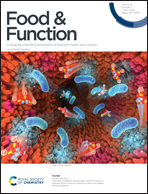In silico prediction aided preparation of antioxidant soybean peptides by enzymatic hydrolysis for ameliorating lead exposure-induced toxicity†
Abstract
Food derived bioactive peptides are prominent dietary supplements to protect against oxidative stress induced by lead (Pb) exposure. This study aimed to develop a new strategy for rapid preparation of highly active antioxidant soybean polypeptides (ASPs) against Pb toxicity. In silico enzymatic hydrolysis simulation and antioxidant activity prediction showed that pepsin, chymotrypsin and bromelain can produce peptides with the highest activity. The preparation process was then optimized, and the obtained ASP showed good antioxidant and metal-chelating activities in vitro. An in vivo study showed that ASP exerted prominent protective effects against Pb-induced cognitive impairment and tissue damage in mice by reducing Pb deposition and enhancing the antioxidant capacity in tissues and was superior to Vc, DMSA or their combination in some aspects. ASP composition analysis demonstrated that its prominent antioxidant activity might be attributed to the high proportion of amino acid residues E, L, P and V in the peptide sequence and L, V and A at the C- and N-termini. In conclusion, in silico prediction could facilitate the preparation of ASP. And the ASP prepared with the new strategy exerted prominent protective effects against Pb toxicity.



 Please wait while we load your content...
Please wait while we load your content...